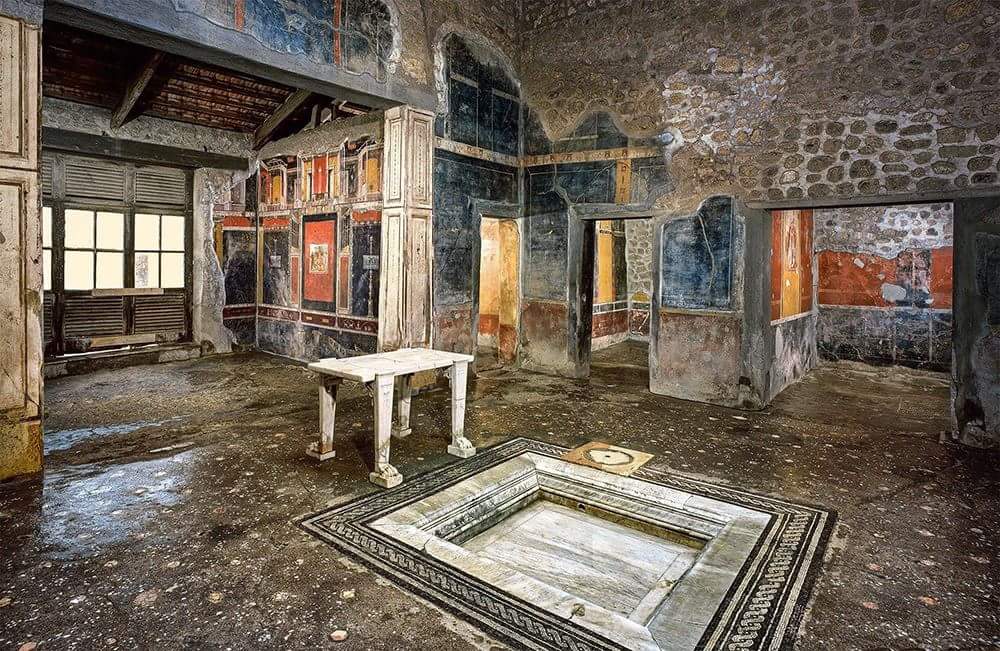Among the numerous domus of Pompeii, one in particular has always aroused my attention: the house of Marco Lucretius Frontone. For those who visit the ancient city, it will seem no easy task to be able to identify it among the articulated secondary streets, as it is hidden in an alley perpendicular to the more famous via di Nola in Regio V, 4, but once you have seen it, the surprise will be really great. The appearance could be deceiving, the façade is quite simple and modest, but it is on crossing the threshold that the curious tourist will find himself in front of one of the most refined atrium houses in Pompeii, whose original layout dates back to the 2nd century BC but which starting from late 1st century BC – early 1st century AD, it was inhabited by one of the most prominent families in the city headed by Marco Lucretius Frontone.

The election inscriptions found on the prospectus of the house during the excavations made it possible to identify the owner who had embarked on a brilliant political career managing to run for the most important public offices. Although the size of the house is modest, only 460 square meters, the domus inside boasts a respectable decorative apparatus, attributable to the final III style, rich in very specific cultural references and worthy of the owner’s remarkable social status. As you enter, there are the tablinium and the atrium with a marble basin of the impluvium bordered by mosaics and with a floor with colored marble chips that characterize the richness of the house, but it is by deepening the visit that you will be soon able to appreciate even more the dwelling.

Clearly visible on the eastern side is the marble cartibulum with lion’s paws which served as an exhibitor of the most precious furnishings of the house, furthermore the vision is enriched, in the nearby tablinum, by a wall entirely decorated with frescoes on a black background in the side areas of which there are inserted paintings with maritime scenes supported by painted candelabra, while in the central part there is the most important fresco with the triumph of Bacchus and Ariadne (right side) and Venus and Mars (left side) in which the god is portrayed softly bending over Venus while seductively caresses her breast in front of Cupid.

Accanto al tablinio, si apre un cubicolo sulle cui pareti affrescate con un intenso giallo ocra vi sono degli amorini che fanno da cornice a delle scene moraleggianti: Narciso intento a specchiarsi e ad ammirarsi nell’acqua e Perona che allatta in prigione il vecchio padre Micone salvandolo così dalla morte. La raffigurazione di amore per il padre è ulteriormente esaltata anche da alcuni versi in distici elegiaci che recitano: “triste pudore fuso con pietà”. Ai lati dell’ingresso del cubicolo, inoltre, a completare la decorazione, vi sono anche due medaglioni raffiguranti dei fanciulli, un maschio e una femmina, forse i figli di Marco Lucrezio Frontone a cui probabilmente erano rivolti gli insegnamenti morali. Sul lato sud dell’atrio si apre un altro cubicolo, questa volta forse di proprietà della domina, in quanto caratterizzato da un’atmosfera tipicamente femminile; sul quadro della parete destra Arianna porge a Teseo il filo che gli consentirà di uscire dal labirinto visibile sullo sfondo, mentre sul lato opposto è raffigurata una scena di toelette di Venere che seduta seminuda davanti ad uno specchio si fa acconciare i capelli.
/013%20M.L.Frontone%20(Casa%20di).%20Pittura%20parietale%20nel%20tablino.jpg)
Nella sala triclinare si conserva un’altra famosa pittura raffigurante l’uccisione di Neottolemo per mano di Oreste davanti al tempio di Apollo a Delfi. La parte posteriore della domus è poi occupata da ambienti secondari come la cucina e la latrina dal viridario e da un portico con tre colonne su cui si affacciano diversi ambienti di soggiorno tra cui il triclinio sulla cui parete sinistra si riconosce Dioniso appoggiato al Sileno con la lira. Nella domus sono stati ritrovati anche cinque scheletri di adulti e tre di bambini schiacciati dal crollo del tetto durante l’eruzione del 79 d.C.

All’esterno è presente anche uno splendido giardino in cui su una parete di fondo è visibile uno splendido affresco con scena di paradeisos in cui si snodano scene di caccia alle belve feroci (leoni, pantere, orsi) e animali domestici (tori, buoi, cavalli). Questi affreschi, in questo lato della casa, si riconducono al IV stile, probabilmente furono eseguiti dopo il terremoto del 62 d.C. e in parte ancora in corso di ristrutturazione quando avvenne l’eruzione, come dimostra il ritrovamento di un’anfora, in una zona di servizio, con della calce.





